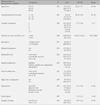Abstract
Methods
This was a cross sectional descriptive study with 255 pregnant women who visited a general hospital in a metropolitan city for their regularly scheduled check-up. Measurement tools employed were the Korean version of Beck Depression Inventory (BDI), the food habits, and the Pittsburg Sleep Quality Index (PSQI). Socio-demographic variables and the status of high risk pregnancy were identified. Influencing factors on antenatal depression were identified using a stepwise multiple regression analysis.
Results
The mean score of antenatal depression was 7.2 ± 5.0; 18.4% with mild depression, 5.9% had moderate depression, with 0.8% identified with severe depression on BDI scale. Influencing factors on antenatal depression accounted for 47.8% of the total variance which consisted of quality of sleep, marital satisfaction, food habits, gestation periods, sexual satisfaction, high risk pregnancy, and age.
Figures and Tables
Table 1
Socio-demographic Characteristics, Antenatal Depression, Food Habits and Quality of Sleep (N=255)

References
1. Adouard F., Glangeaud-Freudenthal N.M.C., Golse B. Validation of the Edinburgh postnatal depression scale (EPDS) in a sample of women with high-risk pregnancies in France. Archives of Women's Mental Health. 2005. 8(2):89–95.
2. Bowen A., Muhajarine N. Prevalence of antenatal depression in women enrolled in an outreach program in Canada. Journal of Obstetric Gynecologic and Neonatal Nursing. 2006. 35(4):491–498.
3. Brandon A.R., Trivedi M.H., Hynan L.S., Miltenberger P.D., Labat D.B., Rifkin J.B, et al. Prenatal depression in women hospitalized for obstetric risk. Journal of Clinical Psychiatry. 2008. 69(4):635–643.
4. Buysse D.J., Reynold C.F. III, Monk T.H., Berman S.R., Kupfer D.J. The Pittsburgh Sleep Quality Index: A new instrument for psychiatric practice and research. Journal of Psychiatric Research. 1989. 28(2):193–213.
5. Buysse D.J., Nofzinger E.A., Keshavan M.S., Reynolds C.F., Kupfer D.J. Turek F.W., Zee P.C, editors. Psychiatric disorders associated with disturbed sleep and circadian rhythms. Regulation of sleep and circadian rhythms. 1999. New York: Marcel Dekker Inc;597–641.
6. Cho E.J. Subjective sleep quality in depressed and non-depressed mothers during the late postpartum period. Korean Journal of Women Health Nursing. 2009. 15(2):108–120.
7. Choi M.K., Jun Y.S., Kim A.J. A survey on dietary behavior and nutrient intake of smoking male college students in Chungnam area. Journal of the Korean Dietetic Association. 2001. 7:248–257.
8. Dayan J., Creveuil C., Marks M.N., Conroy S., Herlicoviez M., Dreyfus M, et al. Prenatal depression, prenatal anxiety, and spontaneous preterm birth: A prospective cohort study among women with early and regular care. Psychosomatic Medicine. 2006. 68:938–946.
9. Freeman M.P.. Antenatal depression: Navigating the treatment dilemmas. American Journal of Psychiatry. 2007. 164(8):1162–1165.
10. Jomeen J., Martin C.R. Assessment and relationship of sleep quality to depression in early pregnancy. Journal of Reproductive and Infant Psychology. 2007. 25:87–99.
11. Kim E.S., Ryu S.Y. The relationship between depression and sociopsychological factors in pregnant women. Journal of the Korean Society of Maternal and Child Health. 2008. 12(2):228–241.
12. Kim G.D. A study on quality of sleep and emotional health status in the elderly. 1998. Daegu: Kyungpook National University;Unpublished master's thesis.
13. Kim H.W. Development of the pregnancy nutrition knowledge scale and its relationship with eating habits in pregnant women visiting community health center. Journal of Korean Academy of Nursing. 2009. 39(1):33–43.
14. Kim S.O. Postp artum dep ression and maternal identity of the high risk women. 2009. Gangreung: Kwandong University;Unpublished master's thesis.
15. Kim Y.R. Depression during pregnancy and the postpartum. Korean Journal of Psychosomatic Medicine. 2007. 15(1):22–28.
16. Kitamura T., Yoshida K., Okano T., Kinoshita K., Hayashi M., Toyoda N, et al. Multicenter prospective study of perinatal depression in Japan: Incidence and correlates of antenatal and postnatal depression. Archives of Women's Mental Health. 2006. 9(3):121–130.
17. Kwon M.K. Antenatal depression and mother fetal interaction. Journal of Korean Academy of Child Health Nursing. 2007. 13(4):416–426.
18. Lee S.H., Kim M., Lee E.H., Suh S.Y., Yook K.W., Choi T.K. Effect of a qigong-based stress management program on emotion of pregnant women. Korean Journal of Psychosomatic Medicine. 2004. 12(2):135–144.
19. Leigh B., Milgrom J. Risk factors for antenatal depression, postnatal depression, and parenting stress. BMC Psychiatry. 2008. 8(24):1–11.
20. Lindgren K. Relationships among maternal-fetal attachment, prenatal depression, and health practices in pregnancy. Research in Nursing & Health. 2001. 24:203–217.
21. O'Keane V., Marsh M.S. Depression during pregnancy. British Medical Journal. 2007. 334(7601):1003–1005.
22. Robertson E., Grace S., Wallington T., Stewart D.E. Antenatal risk factors for postpartum depression: A synthesis of recent literature. General Hospital Psychiatry. 2004. 26(4):289–295.
23. Ross L.E., Murray B.J., Steiner M. Sleep and perinatal mood disorders: A critical review. Journal of Psychiatry & Neuroscience. 2004. 30(4):247–256.
24. Sung T.L. Understandable statistical analysis using SPSS/AMOS: From descriptive statistics to structural equation model. 2007. Seoul: Hakjisa.




 PDF
PDF ePub
ePub Citation
Citation Print
Print




 XML Download
XML Download